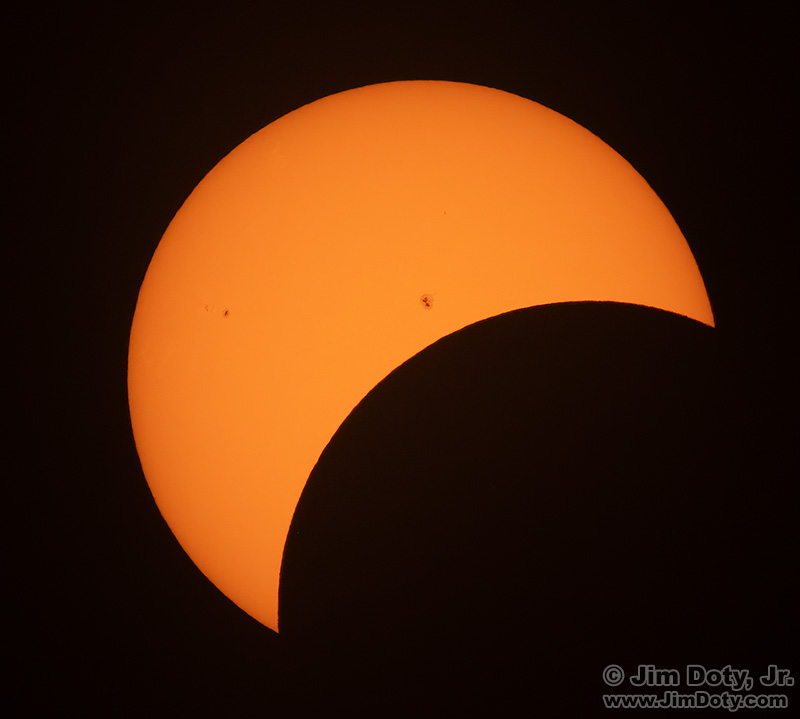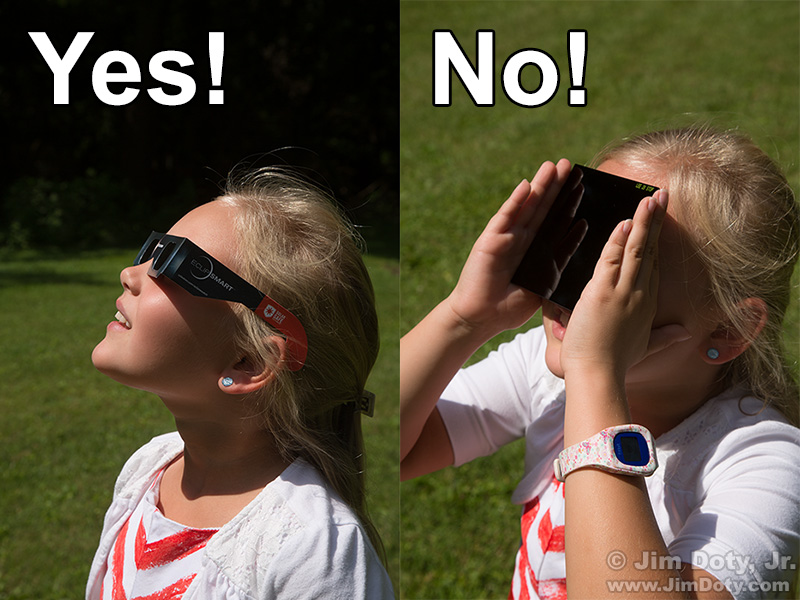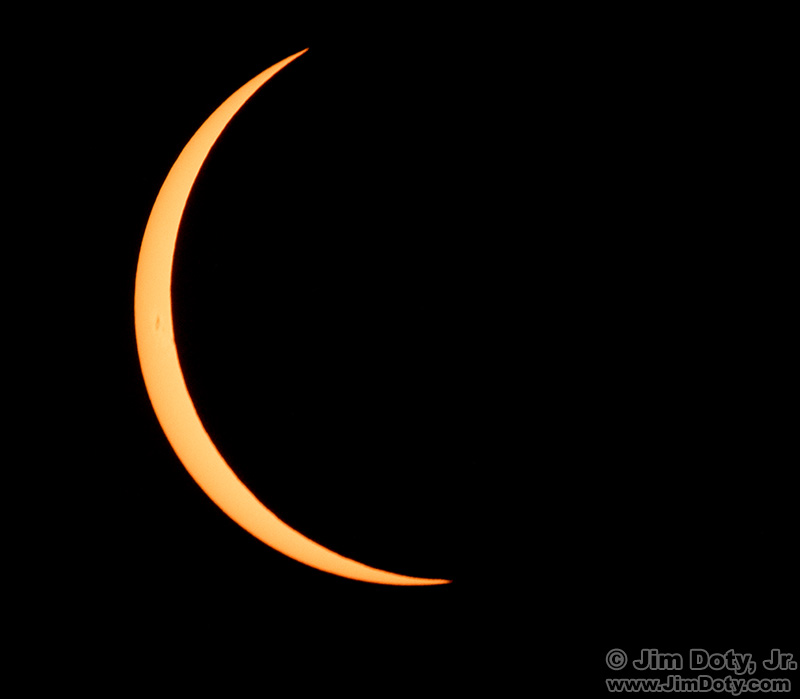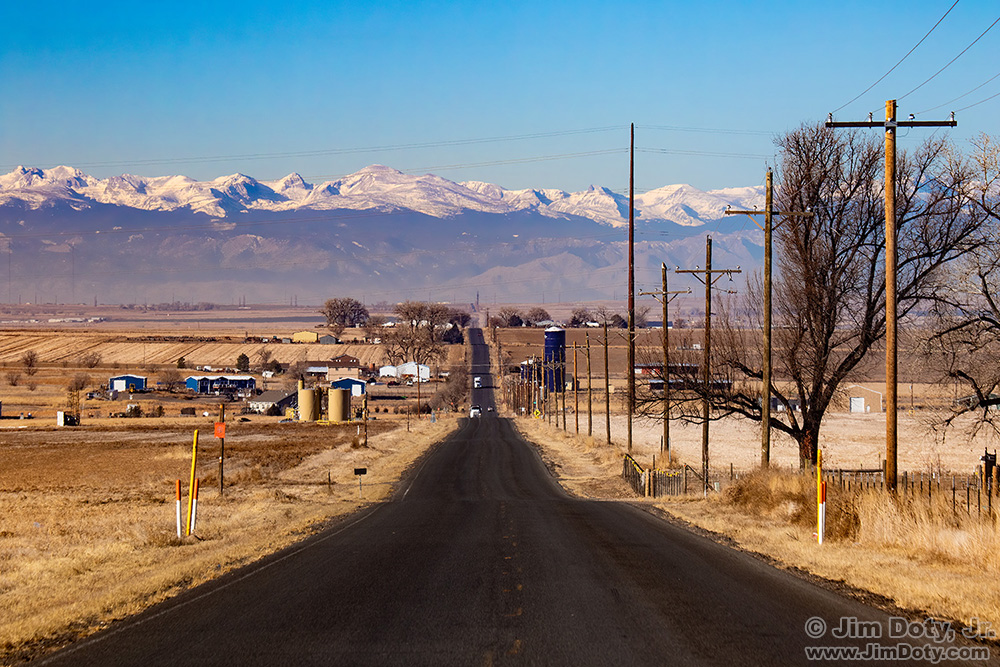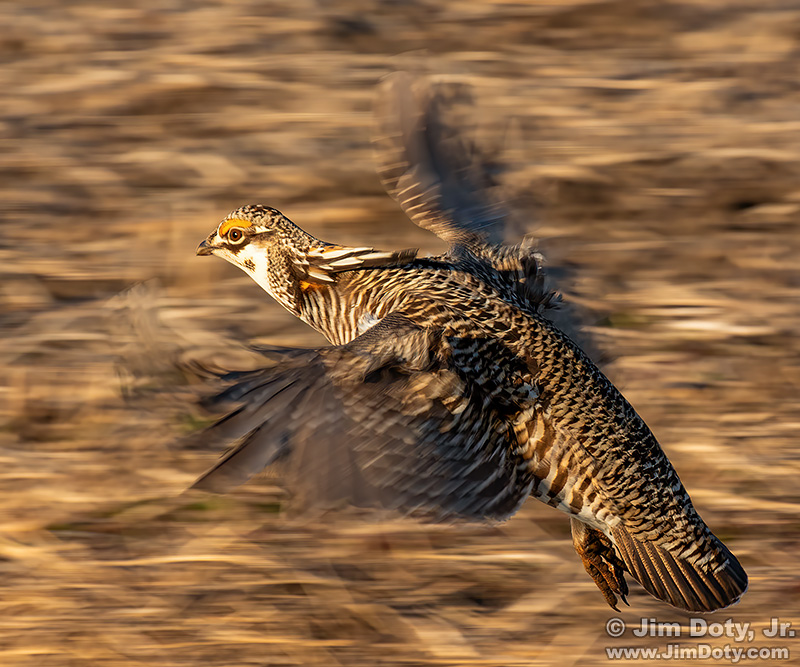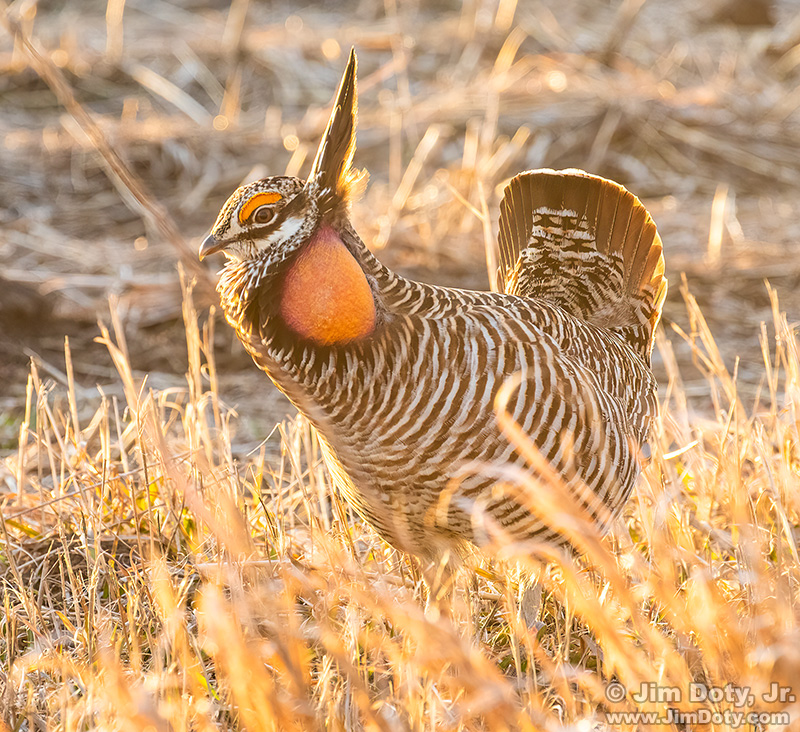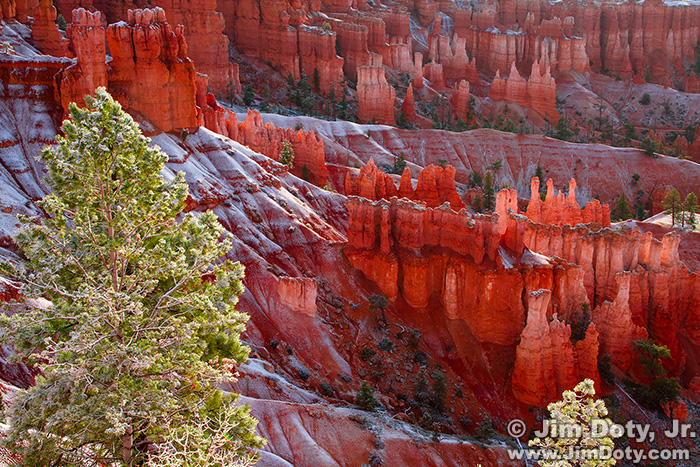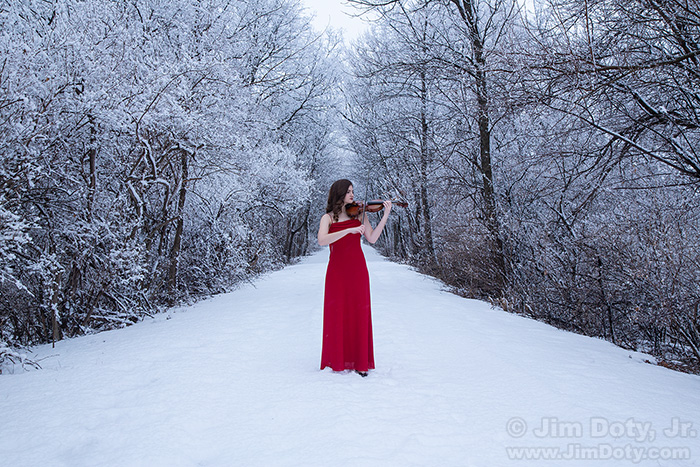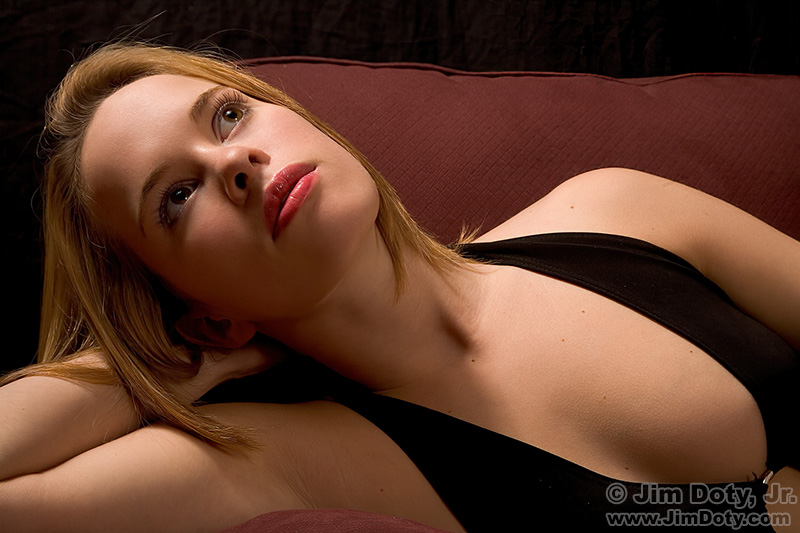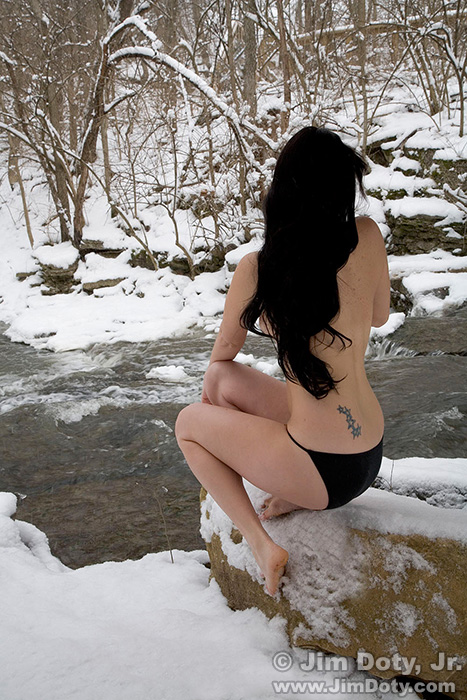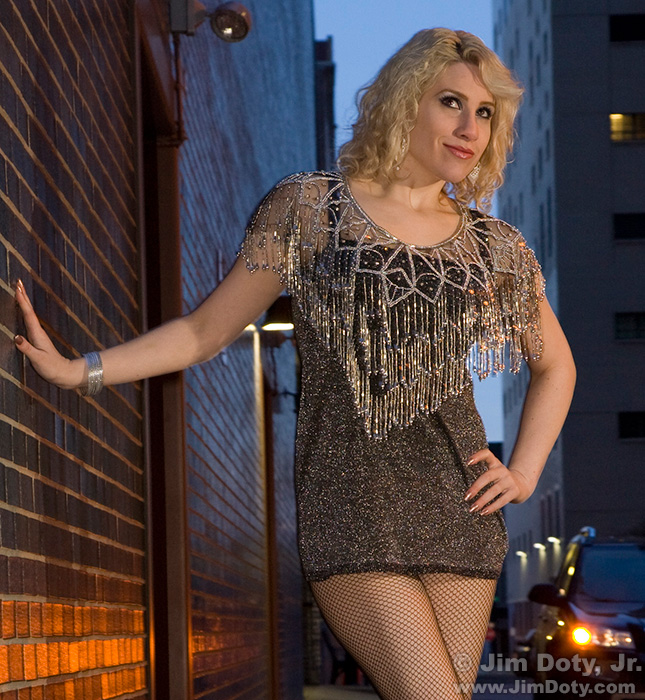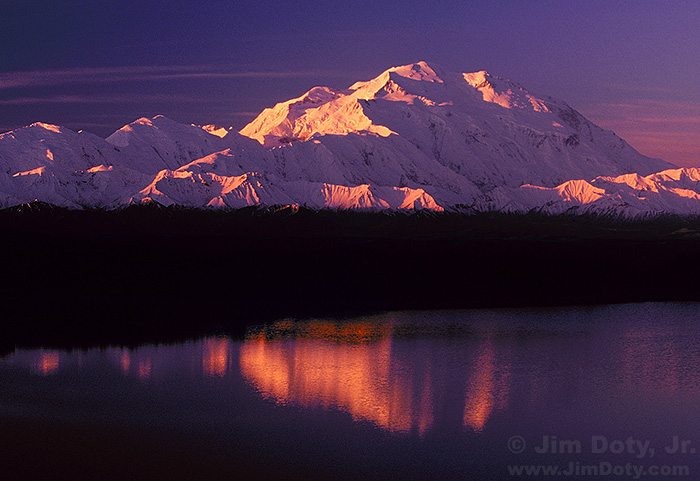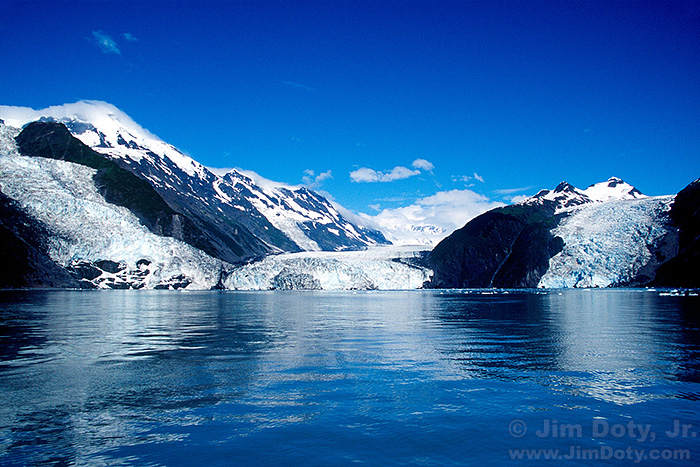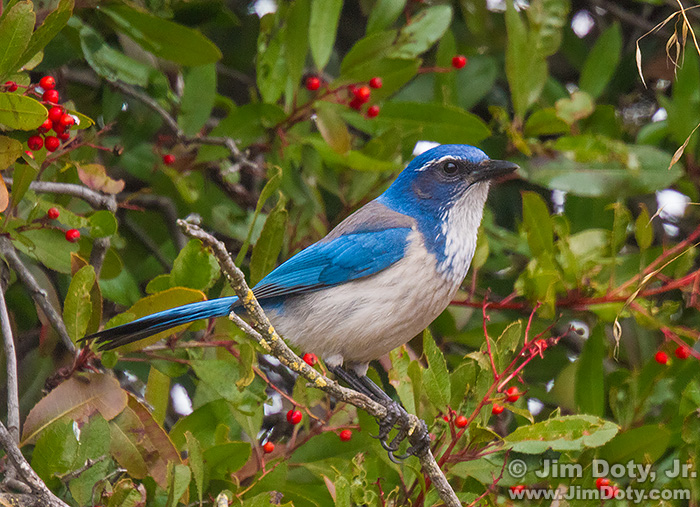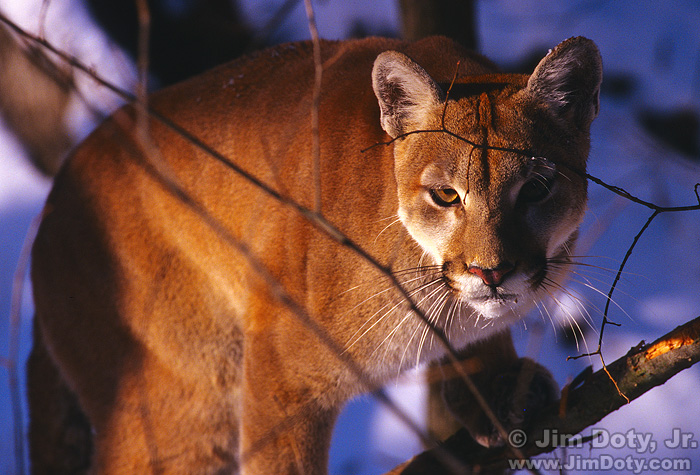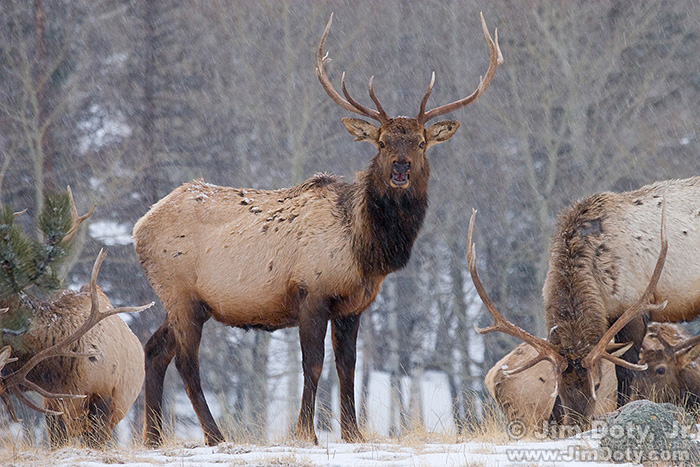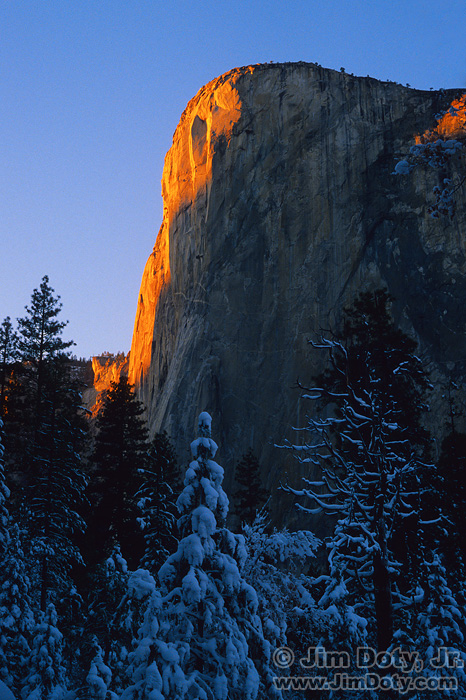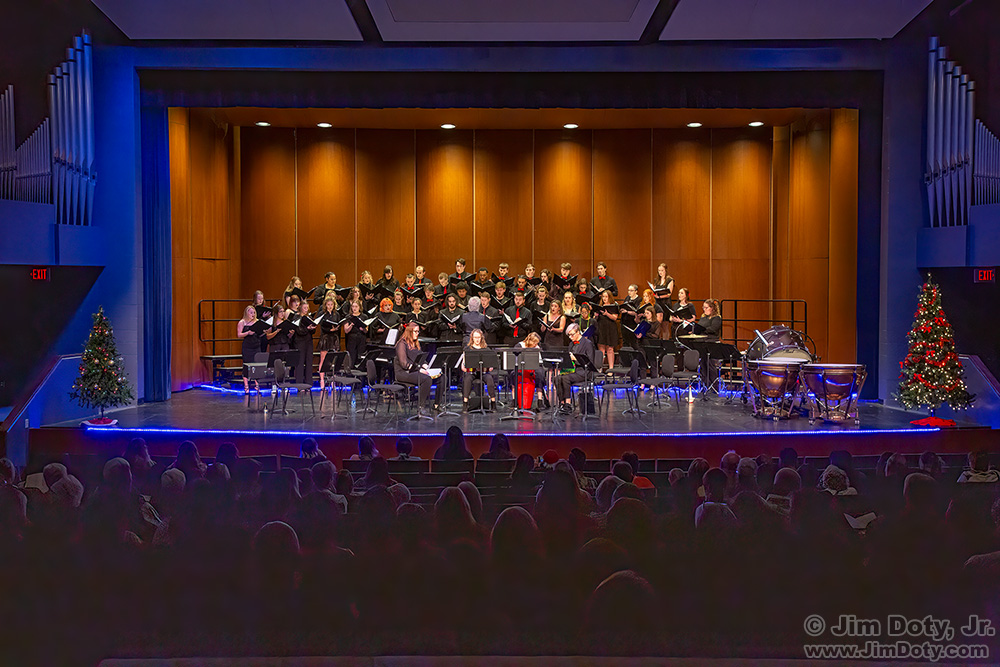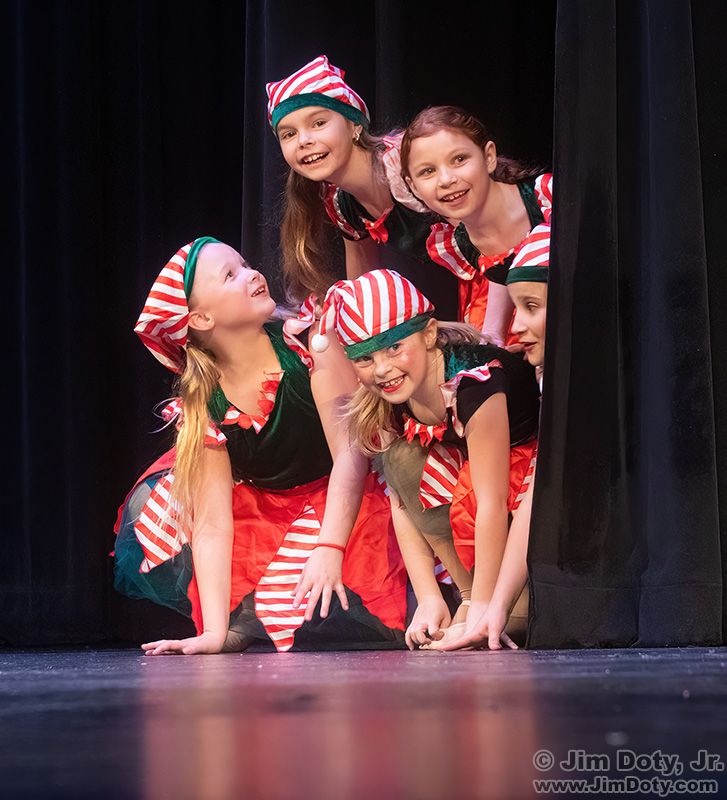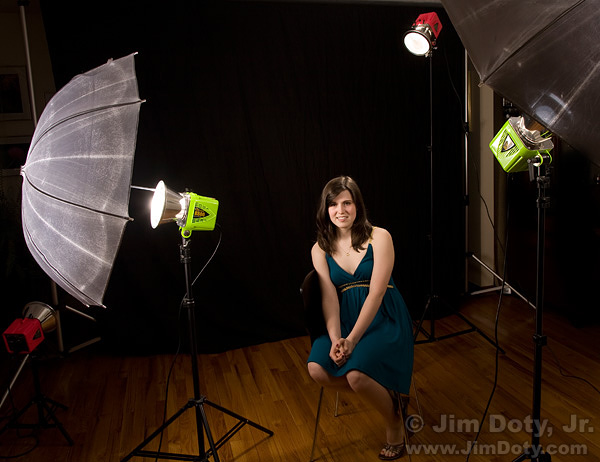This is my favorite eclipse photo because I can see all of the sunspot areas before they disappeared behind the Moon.
Do NOT Look at the Eclipse Through a High Density Solar Eclipse Filter! You Could Go Blind!
Don’t worry. My model’s eyes were closed for the illustration photo on the right.
With the eclipse just around the corner, I am re-posting and updating this article from February 23. Do not look at the sun on eclipse day (or any other day) through a high density solar eclipse filter. Even though you are looking through a solar eclipse filter (i.e. solar filter) you can still go blind. And this is especially true looking through a camera and lens, even with a solar filter on the lens. Why? I am glad you asked.
How to Photograph the “Great American Eclipse” – April 8, 2024
This is updated from the February 22, 2024 article. If you have your solar filter ready to go, this is what you need to do to photograph the eclipse. If you don’t have a solar filter, you might still be able to get one. Check out the White Light solar filters (my first choice) from Thousand Oaks Optical or the Lee high density solar filters.
This is your guide to photographing the Second “Great American Eclipse”, April 8, 2024. The path of totality will cross the entire country from Oregon to South Carolina. This handy guide will help you photograph the eclipse. Planning ahead is key.
Using PeakFinder To Find the Names of the Mountains in Your Photos
I have always loved the view of the Colorado Front Range as I approach the mountains from the eastern plains. I was going to stop in Keenesburg Colorado to get gas, so on that stop I found this county highway northwest of town to take a picture of the mountains. Back home at my computer I decided to figure out the names of some of these mountains.
The Best National Parks to Photograph in Spring
Which national parks are at their very best in the spring? If I could go on a fabulous spring photography trip to the national parks of my choice, all expenses paid, which ones would I pick? Here are my choices, grouped by state from west to east. This list includes the favorites I have been to and want to go back to again, plus the ones I haven’t seen and most want to photograph.
This Morning’s Best Photos
Some mornings I take our dog on a tour of the four local lakes. I always have a camera and at least three lenses with me. Our first stop was to see if the local Greater Prairie Chicken was out and about. He was.
More Greater Prairie Chicken Excitement!
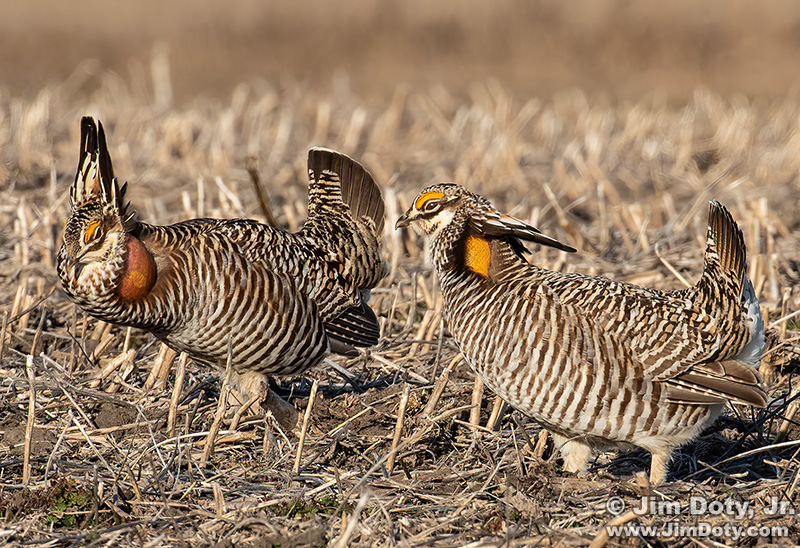
Greater Prairie Chickens, Elk Chapel Road, northwest of Lamoni Iowa. Sunday, February 25, 2024. 8:27 am.
I’ve been back to the prairie chicken location a few times over the last week, but I have not spotted him since February 18. That all changed Sunday morning. And there were two males instead of one!
Greater Prairie Chicken Excitement!
A male Greater Prairie Chicken has taken up residence on the edge of a cornfield about 30-40 feet from a county highway, much to the delight of bird watchers. I got a call from a friend, so I grabbed my camera gear and drove out to the location. This image (above) was taken with the sun low in the west so this prairie chicken has wonderful, warm backlighting. Compare this light to the next photo.
Winter Photography Safety Essentials
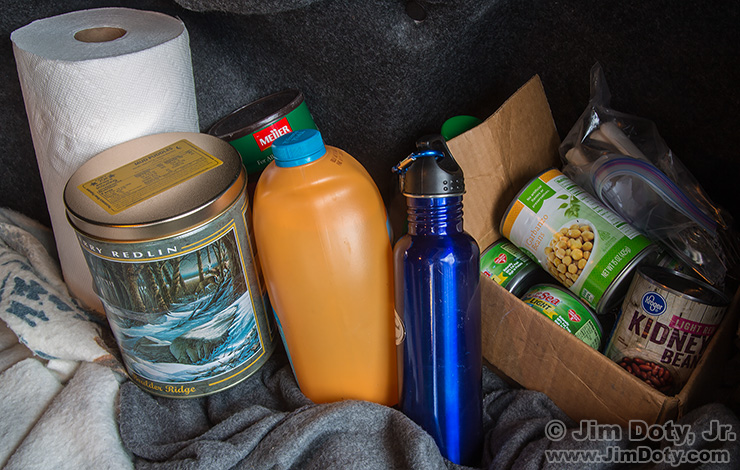
Some of the winter travel items I carry in the trunk of my car. This is the “kitchen” and “furnace”.
I grew up in Colorado where strange weather can strand you in any month of the year. Even though it is rare, I’ve seen blizzards in the Colorado high country in July. So I learned to carry some safety essentials when doing winter photography in remote locations. You never know when you might be stranded for several hours, a whole day, or longer, until the blizzard abates and someone can come find you. This is what I carry in my car when I hit the road in the winter and pretty much any time I am going to be in the High Rockies. I include a few winter travel tips, too.
How to Protect Your Camera Gear in the Cold and Snow
It is still really cold out there so be careful to protect your camera gear. Cold and snow can cause a lot of damage to your camera gear. Something as simple as shooting outside and taking your camera inside your house or car can cause hidden damage that won’t show up until days or weeks later. The simple steps in this article could save you hundreds of dollars in repair bills.
“Black and White”
These images were created 14 hours apart, the first at night against a black backdrop and the second in the afternoon against a bright, window shade. In the second she is entirely backlit. It did not occur to me until this week that these two images could be combined. It is a happy accident that they are facing each other.
Beth in the Snow
February 12 is a red letter day! It started when Beth and I did a photo shoot in a snow storm in January 2020. We had so much fun we wanted to do it again. I was working in my office four years ago today and I looked out the window. Big, beautiful snowflakes were falling. I said to myself, “This would be a great day for another photo shoot in the snow.”
The Best National Parks to Photograph in Winter
There is still some winter left and some national parks look much better than others in winter. I am sharing this post again for those of you who might be planning a trip.
Winter provides some wonderful photo opportunities in our national parks. But some national parks look much better in the winter than others. So if you haven’t gone into hibernation for the winter, here are the best national parks to go photograph this winter, grouped by state from the west to the east. There are a few bonus locations thrown in too. At the end I give you my “best of the best” list.
Rachel in Rembrandt Lighting
This is Rembrandt lighting. The best clue is triangle shaped light on her right cheek.
How to Photograph a Musician in the Cold and Snow
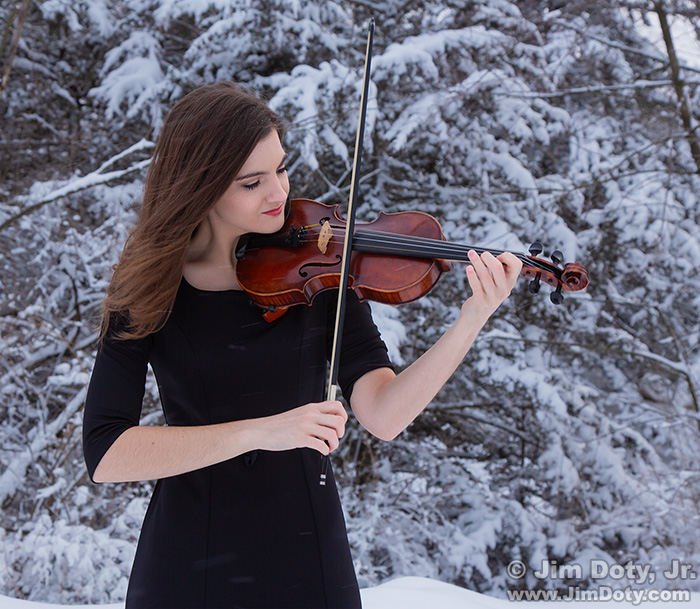
It was my happy privilege to do winter portraits of Beth Presler who is a superb violinist. This article has suggestions for photographing any musician on a cold, snowy winter day.
How to Protect Your Camera Gear in the Cold and Snow
Cold and snow can cause a lot of damage to your camera gear. Something as simple as shooting outside and taking your camera inside your house or car can cause hidden damage that won’t show up until days or weeks later. The simple steps in this article could save you hundreds of dollars in repair bills.
How to Photograph a Nude Model in the Cold and Snow
It is difficult enough to create a beautiful nude image under normal circumstances, much less in the cold and snow. You need to bring some significant skills and experience to the task. So does your model.
How To Work With A Model (or Anybody Else) When The Windchill is 4°
You would think a windchill of 4° Fahrenheit (-16°C) would be too cold for a photo shoot, but not with some models. Selina and I booked this January shoot weeks in advance so we knew it would be cold, but we had no idea how cold until the day arrived. Despite the frigid temperatures, Selina did no want to reschedule for later. Here’s the story behind this image and how to work with a model (or anybody else) when it is so cold.
The Sunny f16 Rule Isn’t Reliable in Winter
The Sunny f16 rule is really useful on bright sunny days in the spring, summer, and fall, but you can’t rely on it for accurate exposures on bright, snowy winter days. It will often lead you astray and you will have seriously blown out highlights. There are much more accurate ways to meter in the winter.
Testing Your Camera’s Snow Exposure Latitude
The “snow exposure latitude” for every camera is different. You won’t find it in your camera’s manual but it is easy to determine with a do-it-yourself test. Why does it matter? If you don’t know the snow exposure latitude for your camera and how to apply it to your images, the color and quality of your winter photos will suffer.
Finding a Photo Location
10 years ago this morning I was at the Don Edwards San Francisco Bay National Wildlife Refuge in Fremont California. I spotted this pretty blue bird while driving around the parking lot at the visitors center. It was in the dry grass grass at first and then hopped into a bush with red berries. As you can see, the bush photo is much better. When I had a chance I looked up this bird. It is a Western Scrub-Jay.
Metering Nighttime Winter Scenes
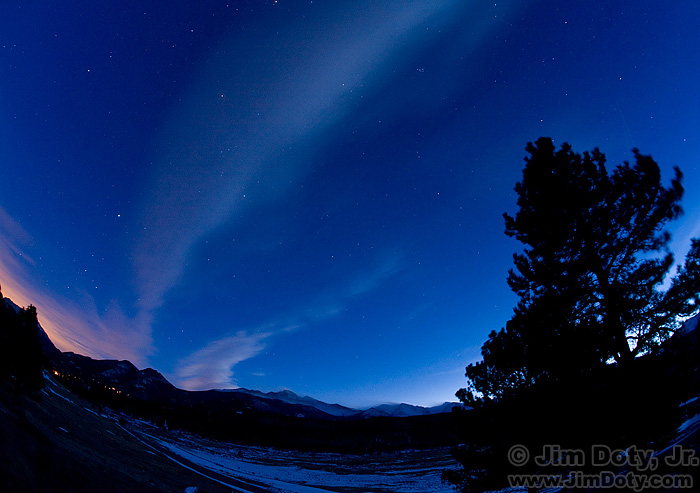
Twilight, Rocky Mountain National Park. Sirius, Canis Major, Orion, Taurus, the Hyades star cluster, and the Pleiades star cluster are all visible in the fading light. Click for a larger version.
You can photograph the night sky year around, but winter brings an added bonus: SNOW! When you don’t have the benefit of moonlight, most of the year land forms a dark to black silhouetted skyline against the night sky. In winter you have the possibility of including the highly reflective snow. You can see both in this photo. Any place not covered with snow is very dark to black. Having reflective snow is why winter is the favorite time of year for a lot of photographers to go out and photograph the night sky.
Metering Evening Winter Scenes
Just like metering daytime winter scenes, the key to metering evening winter scenes is knowing what to meter and deciding how much exposure compensation to use.
Metering Wildlife in the Snow, Part Two
Most wildlife are medium to dark in tone, making them a challenge to meter properly in the bright, white tones of winter. If you trust one of your camera’s automatic exposure modes, the odds are good you won’t get the best exposure. If you switch over to manual exposure and make the right decisions, you can get great exposures and better quality photos (more about that later).
Metering Wildlife in the Snow, Part One
Metering dark toned wildlife in the snow is a major exposure challenge. It is usually best to avoid large “burned out” areas (washed out, featureless white) in a nature or landscape photograph, but with properly exposed snow, the wildlife can be so dark as to lose all texture. On other hand, metering for the wildlife can burn out the snow. So what do you do? And what about the complications of metering white animals?
“How To” Series: Winter Photography
In addition to all of the usual photographic challenges, winter provides some extra complications, especially in terms of metering. So I began this series of articles on winter photography. Check out the links below. The articles will help you meet the unique challenges of winter photography. So get out there, have fun, and create some great winter images!
Christmas at the Shaw
Graceland University’s annual “Christmas at the Shaw” performance was December 8, 2023 at the Shaw Auditorium, Lamoni Iowa. Click the images to see a bigger version. If you would like to purchase prints of these photo, go here.
Dance Performance: Living Art Studios and Graceland Gadets
Dancers in the classes at Living Art Studios teamed up with the Gadets Dance Team from Graceland University for the annual December dance performance. Click on any of the photos (especially the really wide photos) to see a larger version. To purchase prints of these photos, go here.
AlienBees: High Quality, Economical Studio Lights
For the best combination of quality and price, it is hard to beat AlienBees studio lights. I’ve been using AlienBees in my studio for over 10 years, and like so many other photographers, I’ve been singing their praises. It would be hard to find the same quality for less money.
Radio Controlled Speedlites: Yongnuo YN600EX-RT vs Canon 600EX-RT
Should you spend $549 on a Canon 600EX-RT speedlite, or $138 on Yongnuo’s nearly identical clone, the YN600EX-RT? And what about the radio transmitters? Canon’s is $299 and the Yongnuo copy is $95. So you can buy three Yongnuo speedlites plus the radio transmitter for a total of $509, less than the price of one Canon speedlite. The price advantage is clear, but what about quality, reliability, and service issues? Continue reading

